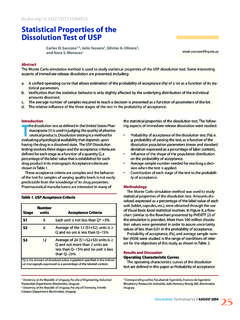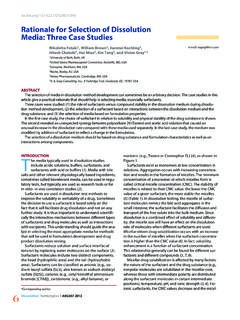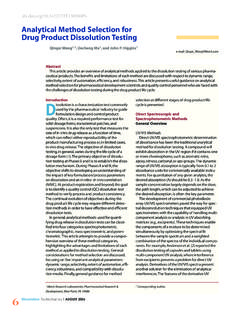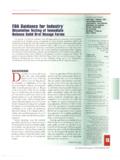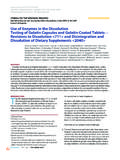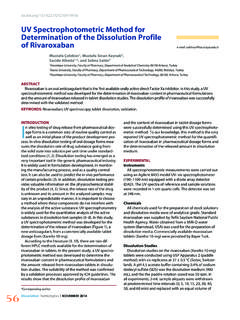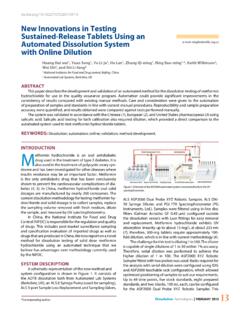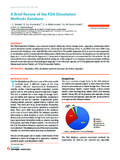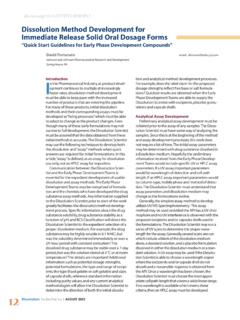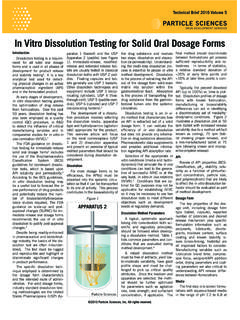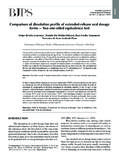Transcription of Development and Validation of In Vitro Release Tests for ...
1 10 DissolutionTechnologies| MAY 2003 Background Historically, it has been challenging to carry out bioavail-ability/bioequivalence studies for semisolid drug productfor the purpose of demonstrating the continued quality,efficacy and sameness of the product upon institutingcertain changes in manufacturing process or substitutionof excipients. Alternatively, in Vitro Tests such as determina-tion of solubility, particle size, rate of Release of the activeingredient and product homogeneity have been the mainmeasures of product uniformity and quality these, in Vitro - Release testing (IVRT ) of activeingredient has drawn much attention as a result of the inissuance of the SUPAC-SS (Guidance for industry for non-sterile semisolid dosage forms)1. Many manufacturers oftopical drugs have devoted significant resources todevelop and validate IVRT during the drug product devel-opment process. However, as pointed out in a FIP/AAPS position paper 2, there is no one standard test protocol thatcan be applied to all semisolid dosage Release test for retinoic acid in various semisolid formu-lations using Franz diffusion cells was developed.
2 The products tested contained retinoic acid in novel formula-tions of either a cream or an ointment base. The IVRT wasdeveloped and validated using Retin-A Cream because itis provided in different strengths and the Release of retinoicacid from Retin-A products have been well method was then applied to formulation develop-ment, and demonstrating the effect of process of In Vitro Release Test1) Assay Method:Although an assay method is normally available for thedrug substance of interest and its related compounds, suchmethod, as is, may not be suitable for the analysis of thesecompounds in the selected receiving medium. In mostcases, a certain degree of method modification and acomplete Validation of the modified method are requiredin order to ensure the quality of IVRT assaymethod was modified (originally validated for retinoic acidand its related compounds) in order to quantify low levelsof retinoic acid in the receiving medium, phosphate buffer(pH ) containing 30-35% of ethanol, which was shown tobe the appropriate range of organic phase for Release ofretinoic acid (page 11).
3 2) Selection of Membrane:The membrane selected should provide an inert holdingsurface for the test formulation, but not a of choice should allow the active ingredient toreadily diffuse into the receiving medium as it is released from the dosage form. It is important to confirm that thereis no interaction, physical or chemical between themembrane and the excipients present inthe formulation may affect the physical integrity of themembrane, or, in many cases, the active ingredient maybind to the membrane. Additionally, the membrane shouldnot contain any leachables that can cause interference tothe assay of the active ingredient. A battery of membraneswas included in the beginning of the method develop-ment: Commonly used membranes are- Tuffryn, Supor (polysulphone), Cellulosic, Acetate Plus (celluloseacetate) Nylon, Teflon, and Polycarbonate. It is recom-mended that standard solutions of the test compound inthe receiving medium be prepared at a couple of concen-tration levels, in the upper and lower concentration rangesexpected in the IVRT experiment, to verify the extent ofdrug binding to the membrane.
4 Commercially availablefilter cartridges were assembled with the tested membranefilters. Standard solutions of retinoic acid were passedthrough these membrane filters, and the filtered standardsolutions were analyzed for retinoic acid retinoic acid containing formulations, drug concen-trations of and g/ml were selected for testingbased on literature reference. Among membranesscreened, polysulphone membranes ( Tuffryn and Supor )showed a significant retention of retinoic acid at low levels( g/ml). Acetate Plus membrane showed bestrecovery with no positive interference by HPLC ( Table 1).Therefore, AcetatePlus was chosen for further develop-ment and of the membrane by soaking in thereceiving medium and/or isopropyl myristate wasrecommended by many investigators. However, for retinoicacid formulations, pre-treatment of the membrane hadlittle or no effect on the overall Release and Validation of In Vitro Release Tests for Semisolid Dosage Forms Case StudyKailas D.
5 Thakker, ,1and Wendy H. Chern, ,21 President, Analytical Solutions, Raleigh, NC2 Director, Product Development , Dermik Laboratories , Aventis Pharmaceuticals, Inc., Berwyn, PATable 1 Recovery of Retinoic Acid from Standard Solutionsafter Passing Through Membrane Filters Membrane Filter1 correspondence to: MAY 20034) Selection of Equipment Related Parameters andCalculation of Drug Release :The following specific equipment related parameters areto be considered in developing a Release :Generally, six Franz diffusion cells are usedfor a test as in dissolution testing to nullify individualdosage form :In most cases where the dosage form isapplied to skin, 32 C is appropriate. Exceptions are whenthe target organ is a membrane such as vaginal mucosa, inwhich case, 37 C is more appropriate. We used 32 C in allthe , 1, 2, 4, 6, 8 (optional) 24 and 48hours (optional).3) Selection of Receiving Medium:Although it is desirable to have a receivingmedium that is similar to the physiological condi-tion of the skin, it is also imperative to ensure thatthe Release of the drug can be measured withoutbias.
6 The most important factor for the selectionof receiving medium is the solubility of the activeingredient in the medium. The receiving mediumshould provide a diffusional sink for the activeingredient released from the semisolid formula-tion. The relationship of Q (cumulative amountreleased) versus T (square root of time) isderived from the Higuchi model4with theassumption that there is a reservoir of the drugalways available to diffuse thru. As a rule ofthumb, there should be no more than 30% of thetotal amount of the dose applied released intothe medium at the end of the pH of the medium is also an importantfactor for consideration. Selection of the pH of theaqueous component of the medium should bebased on the pH of the formulation, pH-solubilityprofile of the active ingredient and the pH of thetarget practical consideration is to choose areceiving medium that allows sufficient amountsof active ingredient released within a reasonabletime period to ensure accurate analysis of therelease rate solubility of retinoic acid in ethanolic-bufferedmedia is sufficient to meet all of the requirementsdiscussed above.
7 After a few preliminary experi-ments, a pH buffer with 35% ethanolwas selected as the receiving medium. Phosphatebuffer with 35% ethanol allowed sufficient levels ofretinoic acid to diffuse through the membrane fromprototype formulations for accurate analysis of retinoic testing of several investigational formulations werecarried out using pH and pH buffers, which were thepH of the tested formulation and skin pH, profiles of the reference product, Retin-A showed higher Release of retinoic acid in pH buffer,while certain prototype formulations (8 & 9) showed littledifference in the Release of retinoic acid into bufferedreceiving media of either pH ( Table 2). The pH buffer:ethanol (65:35 v/v) was used as the receiving medium forfurther changes in alcohol concentration did not result insignificant changes in rate of Release of retinoic acid fromRetin-A Cream. (Figure 1).Table 2 Average Rate of Release * of Retinoic Acid ( g/cm2/hours1/2) fromInvestigational Retinoic Acid FormulationsFormulationsR elease Rate* in pH Rate* in pH Buffer:Phosphate Buffer:Ethanol 65:35 v/vEthanol 65:35 ** *Average slope of the line where square root of time (hours1/2) is the x-axisand cumulative amount released (ug/cm2) is the y-axis.
8 ** Poor Release , slope cannot be calculatedFigure 1: Average Release of Retinoic Acid from Retin-A Cream Through AcetatePlus Membrane into Ethanolic Buffered Cumulative Amount Released g/cm2 Sampling Volume:200 l at each time point withvolume replaced with fresh medium every :The cumulative amount (Q) of retinoic acid released persurface area of membrane is:n-1Q = { CnV + Ci S }/Ai=1 WhereQ = Cumulative amount of retinoic acid released persurface area of membrane ( g/cm2) Cn= Concentration of retinoic acid ( g/ml) deter-mined at nth sampling =Volume of individual Franz diffusion cell n-1 Ci= Sum of concentrations of retinoic acid ( g/ml) i=1determined at sampling intervals 1 through n-1 S = Volume of sampling aliquot, mlA = Surface area of sample well. For this work, thesurface area was of the In Vitro Release Test Developed forRetinoic Acid Formulations:Normally, failure formulations with known deficienciesare required to perform the Validation .
9 In this case, themethod was first validated using marketed product, Retin-A Cream, then applied to the investigational formulationswith known differences to confirm the ability of thismethod to differentiate between formulations containingvariables under attributes validated were:1) Reproducibility: Cell-to-cell variability and criteriaused to accept/reject individual data2) Accuracy: Sameness among batches of the samecomposition tested at different ) The effect of dosage strength on the rate of Release 4) The effect of changes in composition on the rate ofrelease 5) The effect of changes in process parameters on therate of Release 6) The effect of changes in viscosity of the dosage formon rate of Release 1) Reproducibility: Cell-to-cell variability and criteriaused to accept/reject individual dataIn absence of calibrators for the Franz diffusion cell appa-ratus, an in-house standard, Retin-A Cream wasused as reference.
10 Additionally, the slope and correlationcoefficients for the line described by the square root oftime (x-axis) and the cumulative amount released persurface area (y-axis) were calculated for each cell daily. Theline with correlation coefficient < was ) Accuracy: Sameness among batches of the samecomposition tested at different batches of investigational retinoic acid formula-tion lots with identical composition, prepared by the sameprocess yielded very comparable slope values on 3shows one ) The Effect of Dosage Strength on The Rate of Release :IVRT of retinoic acid in Retin-A Creams , were determined using the conditions 2shows the Release profile of retinoic acidfrom these Release rate and the totalamount of drug released are proportional to the strengthof the Retin-A Cream in ethanol 65/35 (v/v): pH phosphate buffer: ethanol (65:35 v/v).Figure 3 (page 14) shows the Release profiles of three lotsof the same investigational retinoic acid formulations, twoat and one at drug concentration.
